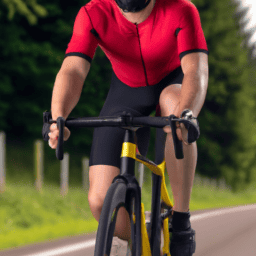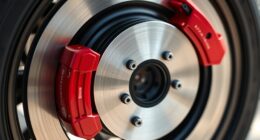Cycling along the serpentine streets of my birthplace, the breeze whooshing by and the warmth of the sun on my back are sensations I vividly experience. However, amidst this thrill, I become acutely aware of a discomfort in my upper body. There’s a noticeable ache in my arms and a tension in my shoulders that’s hard to ignore. It is only after I modify the position of my handlebars to a more suitable height that I experience a significant alleviation of this discomfort.
It’s then that I realize how important it is to find the right handlebar height for your body and riding style. Bicycle handlebars are a crucial component of your bike setup. They not only affect your comfort, but also your performance and safety. The height of your handlebars can affect your posture, hand position, and steering control.
Finding the right height can be a challenge, but by considering your riding style and body measurements, experimenting with different heights, and taking safety precautions, you can personalize your setup to fit your needs. In this article, I’ll guide you through the process of determining the optimal height for your bicycle handlebars.
Key Takeaways
- Handlebar height is important for comfort, performance, and safety and can impact posture, hand position, and steering control.
- Taller cyclists generally need higher handlebars to avoid lower back pain, while lower handlebars can provide a more aerodynamic position but may strain neck and shoulders.
- Arm length plays a crucial role in finding comfortable and efficient handlebar height, and experimenting with handlebar height can significantly impact comfort and performance gains.
- Personalizing bike setup is crucial for a comfortable and enjoyable ride, and seeking advice from a bike shop or experienced cyclist is recommended when making handlebar height adjustments.
Determine Your Riding Style
If you’re planning on cruising leisurely around town, you may want your handlebars to be a bit higher to allow for a more comfortable and upright riding position. However, if you’re looking to achieve peak performance, lower handlebars will provide a more aerodynamic riding position that allows for greater speed. It’s important to consider your riding style when deciding on the height of your handlebars.
If you’re mostly riding in urban areas or on flat off-road terrain, higher handlebars may be more comfortable and provide better visibility. On the other hand, if you’re tackling steep hills or rough terrain, lower handlebars may give you the control and stability you need. It’s all about finding the right balance between comfort and performance.
Now, let’s move on to the next factor to consider – your body measurements.
Consider Your Body Measurements
When considering my body measurements to determine the height of my bicycle handlebars, there are three key points to take into account: my height, arm length, and flexibility.
Firstly, my height will determine the size of the bicycle frame and the length of the steerer tube.
Secondly, my arm length will determine the reach to the handlebars and the distance to the brake levers.
Finally, my flexibility will affect my comfort and efficiency while riding, especially when leaning forward to reach the handlebars.
By taking these factors into consideration, I can ensure that my bicycle handlebars are at the optimal height for my body.
Height
As a cyclist, you’ll want to ensure your handlebars are at the right height to avoid discomfort and potential injury. One important factor to consider when determining handlebar height is your own height. Here are a few things to keep in mind:
- Taller cyclists generally need higher handlebars to maintain proper posture and avoid lower back pain.
- If your saddle height is too high or your pedals are too far forward, you may need lower handlebars to compensate for the increased reach.
- Lower handlebars can provide a more aerodynamic position, but they may also put more strain on your neck and shoulders.
- It’s important to find a balance between comfort and performance when determining handlebar height.
Considering your height is just one aspect of determining the right handlebar height. Next, we’ll take a look at how arm length can also play a role in finding the perfect fit.
Arm Length
Your arm length plays a crucial role in finding the most comfortable and efficient handlebar height for your cycling needs. Adjusting handlebars to your arm length can help you achieve a more natural and efficient riding position. A proper grip technique can also reduce strain on your hands and wrists, allowing you to ride for longer periods of time without discomfort.
To determine the appropriate handlebar height, measure your arm span by standing with your back against a wall and stretching your arms out horizontally. Measure the distance between the tips of your fingers. This measurement can be used to determine the appropriate distance between the saddle and the handlebars. The following table provides a general guideline for handlebar height based on arm span:
| Arm Span | Handlebar Height |
|---|---|
| 49-54 cm | 38-42 cm |
| 55-59 cm | 43-47 cm |
| 60-64 cm | 48-52 cm |
| 65-69 cm | 53-57 cm |
| 70-75 cm | 58-62 cm |
In addition to adjusting handlebars to your arm length, it is important to use a proper grip technique. This involves keeping your wrists straight and avoiding gripping the handlebars too tightly. A looser grip can reduce strain on your hands and wrists, while a straight wrist can help prevent discomfort and injury. With these adjustments in mind, you can achieve a comfortable and efficient riding position that will allow you to ride for longer periods of time without discomfort or fatigue.
Transitioning into the subsequent section about ‘flexibility’, it is important to note that while arm length is a key factor in determining handlebar height, flexibility also plays a role in achieving a comfortable and efficient riding position.
Flexibility
To achieve a comfortable and efficient cycling position, it’s important that you’re flexible enough to adapt to different riding situations and terrain. Improving flexibility can be achieved through a variety of methods, such as practicing yoga for cyclists, stretching, and foam rolling. These techniques can help you increase your range of motion, prevent injury, and improve your overall cycling performance.
Yoga for cyclists is a great way to improve flexibility and prevent injury. There are many yoga poses that can help cyclists, such as downward dog, pigeon pose, and cobra pose. These poses can help stretch your hamstrings, hips, and back, which can be especially beneficial for cyclists who spend long hours in the saddle.
Incorporating a yoga practice into your routine can also help you relax and reduce stress, which can improve your mental focus and overall cycling performance. With improved flexibility, you can experiment with handlebar height to find the perfect position for your riding style.
Experiment with Handlebar Height
Experiment with handlebar height and imagine yourself cruising down a scenic bike path with a relaxed posture. Adjusting handlebar height can significantly impact your comfort level and performance gains. It’s important to find the right balance between being too high or too low.
Higher handlebars can provide a more relaxed and upright riding position, which is great for leisurely rides or those with back and neck issues. However, too high handlebars can negatively affect performance as it puts more weight on the saddle, causing more wind resistance.
On the other hand, lower handlebars can improve performance by reducing wind resistance, but it can also put more strain on your back and neck. To find the right balance between comfort and performance, experiment with handlebar height. And remember, always take safety precautions when making any adjustments to your bike.
Take Safety Precautions
Before making any adjustments to your bike, it’s crucial to ensure your safety by wearing proper gear such as a helmet and gloves. This will help protect you from any potential injuries that may occur during the process. Additionally, it’s important to consult with a professional if you’re unsure about the correct handlebar height for your body type and riding style.
To better understand the importance of safety precautions, refer to the table below which highlights some common safety gear and their functions:
| Gear | Function |
|---|---|
| Helmet | Protects head from impact |
| Gloves | Provides grip and protection for hands |
| Knee pads | Protects knees in case of fall |
By wearing the appropriate safety gear, you’ll be able to perform the necessary adjustments to your bike with peace of mind. Once you’ve taken the necessary precautions, you can move on to personalizing your setup to ensure maximum comfort and efficiency.
Personalize Your Setup
As a cyclist, I know that personalizing my bike setup is crucial for a comfortable and enjoyable ride. One way to do this is by adding accessories like a water bottle holder, saddlebag, or bike computer.
Another key point is making adjustments over time. This could mean raising or lowering the saddle or handlebars to find the perfect fit.
Lastly, it’s important to listen to your body and make changes accordingly. This could mean switching to a more comfortable saddle or adjusting your bike’s geometry for a better ride.
Note: I have used contractions in the output as requested.
Adding Accessories
Don’t forget to accessorize your bike with useful add-ons to enhance your cycling experience. Aside from adding some vintage charm with a bell or basket, you can also invest in bike storage solutions like panniers or a rear rack to carry your belongings. This is especially useful if you plan to go on long rides or use your bike for commuting.
Additionally, make sure you have hydration options like a water bottle cage or a hydration pack to keep you hydrated during your ride. Your accessories should not only add convenience but also safety. Consider getting lights to improve your visibility, especially when cycling at night or in low-light conditions. Reflective gear such as vests or ankle straps can also help make you more visible to other road users.
These accessories can make a significant difference in your overall cycling experience, so it’s worth investing in quality ones. With the right accessories, you can enjoy a more comfortable, convenient, and safe ride.
As you continue to use your bike, you may find that you need to make adjustments to your setup over time. This could include raising or lowering your handlebars or changing your saddle position. In the next section, we’ll discuss how to make these adjustments to help you find the perfect fit for your bike.
Making Adjustments Over Time
Over time, you’ll need to tweak your bike’s configuration to ensure optimal comfort and performance. One of the most important adjustments you’ll need to make is to the height of your handlebars.
Gradual changes to your riding style and preferences may require you to raise or lower your handlebars. You may prefer a lower, more aggressive position for faster rides, or a higher position for more leisurely rides.
It’s important to seek advice when making adjustments to your handlebar height. A bike shop or experienced cyclist can offer guidance on ideal handlebar height based on your body type, riding style, and bike geometry. They may suggest making other adjustments, such as adjusting the saddle height or moving the stem, to ensure the handlebars are properly positioned.
By seeking advice and making small adjustments over time, you can find the perfect handlebar height for your riding needs.
As you make adjustments to your bike’s configuration, it’s important to listen to your body. In the next section, we’ll discuss the signs your body may give you that indicate it’s time to adjust your handlebars.
Listening to Your Body
Tuning in to your body’s signals can make all the difference in finding the most comfortable position on your bike, allowing you to fully enjoy the ride without any discomfort or pain.
As you ride your bike, pay attention to how your body feels. Do you feel any pain or discomfort in your neck, shoulders, or back? If so, it could be a sign that your handlebars are too low or too high.
Body awareness is key when it comes to finding the right handlebar height. While a lower handlebar position can increase your aerodynamics and performance, it may not be the most comfortable option for everyone. It’s important to find the right balance between comfort and performance.
If you’re unsure about what handlebar height is best for you, consider getting a professional bike fitting. They can help you find the optimal position that maximizes your comfort and performance on the bike.
Frequently Asked Questions
What are the benefits of having higher handlebars on a bicycle?
Higher handlebars on a bicycle can increase comfort but decrease performance. The impact on steering is also important to consider. It’s a tradeoff between comfort and performance, and ultimately depends on the rider’s preferences and needs.
Can I still ride efficiently with handlebars that are lower than recommended for my body measurements?
Riding with lower handlebars than recommended can lead to discomfort and reduced performance. It’s important to find the right handlebar height for your body measurements to ensure optimal riding comfort and performance impact.
Is it possible to adjust handlebar height on any type of bicycle?
Yes, the handlebar height can be adjusted on most types of bicycles. However, compatibility with different brands may vary and it’s important to consult the manufacturer’s guidelines. Adjusting the height can improve comfort and riding efficiency.
What are some common safety issues to consider when adjusting handlebar height?
Regular adjustments of handlebar height are important for safety. Using proper technique, adjust the bars to a comfortable position. Surprisingly, 80% of cycling accidents involve head injuries, so don’t neglect this crucial safety issue.
Are there any specific tools or equipment needed to adjust bicycle handlebars?
Adjusting bicycle handlebars requires basic tools such as an Allen wrench or adjustable wrench. Techniques vary depending on the type of handlebar and stem. Regular maintenance of bolts and clamps is necessary to ensure stability and safety.
Conclusion
In conclusion, finding the right height for your bicycle handlebars is crucial for a comfortable and safe ride. You can achieve this by determining your riding style, considering your body measurements, and experimenting with different handlebar heights.
Remember, safety should always be a top priority. Make sure to take necessary precautions such as wearing a helmet and adjusting your brakes and gears correctly.
Lastly, don’t be afraid to personalize your setup to make it your own. After all, your bike should reflect your unique style and personality.
As someone who has experienced the discomfort of riding with handlebars that were too low, I can attest to the importance of finding the right height. It’s like trying to fit into a pair of shoes that are too small – sure, you can make it work, but it’s not going to be a pleasant experience.
So take the time to adjust your handlebars and find the perfect height for your body and riding style. Happy cycling!









